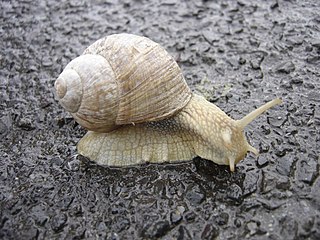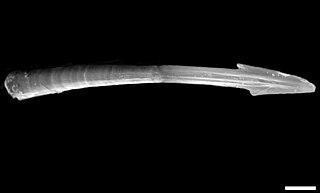Related Research Articles

A snail is, in loose terms, a shelled gastropod. The name is most often applied to land snails, terrestrial pulmonate gastropod molluscs. However, the common name snail is also used for most of the members of the molluscan class Gastropoda that have a coiled shell that is large enough for the animal to retract completely into. When the word "snail" is used in this most general sense, it includes not just land snails but also numerous species of sea snails and freshwater snails. Gastropods that naturally lack a shell, or have only an internal shell, are mostly called slugs, and land snails that have only a very small shell are often called semi-slugs.

The gastropods, commonly known as snails and slugs, belong to a large taxonomic class of invertebrates within the phylum Mollusca called Gastropoda.

Caenogastropoda is a taxonomic clade, a large diverse group which are mostly sea snails and other marine gastropod mollusks, but also includes some freshwater snails and some land snails. The clade is the most diverse and ecologically successful of the gastropods.

The grove snail, brown-lipped snail or Lemon snail is a species of air-breathing land snail, a terrestrial pulmonate gastropod mollusc.

Pterostylis is a genus of about 300 species of plants in the orchid family, Orchidaceae. Commonly called greenhood orchids, they are terrestrial, deciduous, perennial, tuberous, herbs found in Australia, New Zealand, New Guinea, New Caledonia and one Indonesian island. The flowers are mostly green, sometimes with brown, reddish or white stripes, and are distinguished from other orchids by their unusual flower structures and pollination mechanism.

Cornu aspersum, known by the common name garden snail, is a species of land snail in the family Helicidae, which includes some of the most familiar land snails. Of all terrestrial molluscs, this species may well be the most widely known. It was classified under the name Helix aspersa for over two centuries, but the prevailing classification now places it in the genus Cornu.

Achatina fulica is a species of large land snail that belongs in the family Achatinidae. It is also known as the Giant African land snail. It shares the common name "giant African snail" with other species of snails such as Achatina achatina and Archachatina marginata.

Terrestrial animals are animals that live predominantly or entirely on land, as compared with aquatic animals, which live predominantly or entirely in the water, or amphibians, which rely on a combination of aquatic and terrestrial habitats. Terrestrial invertebrates include ants, flies, crickets, grasshoppers and spiders.

Sea snail is a common name for slow moving marine gastropod molluscs usually with visible external shells, such as whelk or abalone. They share the taxonomic class Gastropoda with slugs, which are distinguished from snails primarily by the absence of a visible shell.

The gastropod shell is part of the body of a gastropod or snail, a kind of mollusc. The shell is an exoskeleton, which protects from predators, mechanical damage, and dehydration, but also serves for muscle attachment and calcium storage. Some gastropods appear shell-less (slugs) but may have a remnant within the mantle, or the shell is reduced such that the body cannot be retracted within (semi-slug). Some snails also possess an operculum that seals the opening of the shell, known as the aperture, which provides further protection. The study of mollusc shells is known as conchology. The biological study of gastropods, and other molluscs in general, is malacology. Shell morphology terms vary by species group. An excellent source for terminology of the gastropod shell is "How to Know the Eastern Land Snails" by John B. Burch now freely available at the Hathi Trust Digital Library.

Physa is a genus of small, left-handed or sinistral, air-breathing freshwater snails, aquatic pulmonate gastropod mollusks in the family Physidae.

A land snail is any of the numerous species of snail that live on land, as opposed to the sea snails and freshwater snails. Land snail is the common name for terrestrial gastropod mollusks that have shells. However, it is not always easy to say which species are terrestrial, because some are more or less amphibious between land and fresh water, and others are relatively amphibious between land and salt water.

Radix peregra, previously known as Lymnaea peregra or Lymnaea pereger, is a species of air-breathing freshwater snail, an aquatic pulmonate gastropod in the family Lymnaeidae, the pond snails.

Theba pisana, common names the white garden snail, sand hill snail, white Italian snail, Mediterranean coastal snail, and simply just the Mediterranean snail, is an edible species of medium-sized, air-breathing land snail, a terrestrial pulmonate gastropod mollusk in the family Helicidae, the typical snails.

Cecilioides acicula, common name the "blind snail" or "blind awlsnail", is a species of very small, air-breathing land snail, a terrestrial pulmonate gastropod mollusk in the family Ferussaciidae.

A love dart is a sharp, calcareous or chitinous dart which some hermaphroditic land snails and slugs create. Love darts are both formed and stored internally in a dart sac. These darts are made in sexually mature animals only, and are used as part of the sequence of events during courtship, before actual mating takes place. Darts are quite large compared to the size of the animal: in the case of the semi-slug genus Parmarion, the length of a dart can be up to one fifth that of the semi-slug's foot.

Freshwater snails are gastropod mollusks which live in fresh water. There are many different families. They are found throughout the world in various habitats, ranging from ephemeral pools to the largest lakes, and from small seeps and springs to major rivers. The great majority of freshwater gastropods have a shell, with very few exceptions. Some groups of snails that live in freshwater respire using gills, whereas other groups need to reach the surface to breathe air. In addition, some are amphibious and have both gills and a lung. Most feed on algae, but many are detritivores and some are filter feeders.
George Alan Solem, known professionally as Alan Solem, was an American malacologist, a biologist who studied mollusks.

Terrestrial molluscs or land molluscs (mollusks) are an ecological group that includes all molluscs that live on land in contrast to freshwater and marine molluscs.
References
- ↑ Salvador, R.B.; Cavallari, D.C.; Simone, L.R.L. (2015). "Taxonomical study on a sample of land snails from southeastern Tocantins State, Brazil, with description of a new species". Journal of Conchology. 42 (1): 67–78.
| | This Bulimulidae-related article is a stub. You can help Wikipedia by expanding it. |